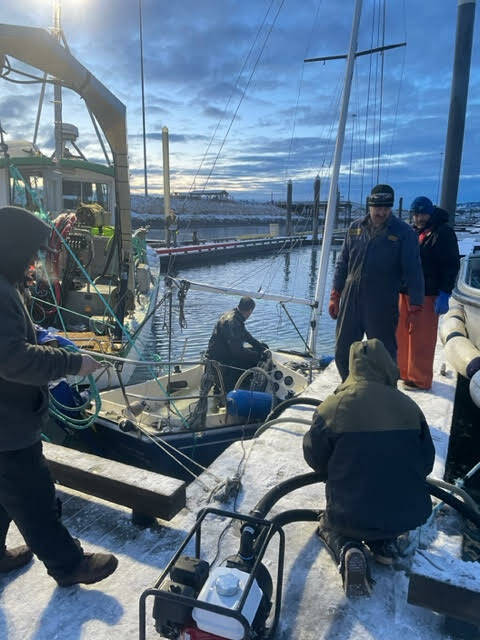Homer Port and Harbor crew, along with a team of contractors, worked last week to salvage a flooded sailboat and remove it from the water.
The crew first responded to reports of a sunken boat on “J” float around 8 p.m. on Dec. 27, Matt Clarke, deputy Harbor Master, said.
Swingshift Harbor officer, Kurt Read, called Clarke promptly after learning of the sunken vessel.
“When a boat sinks in the harbor, we always look at it immediately. We have to assess if we have the ability to use our own equipment, tools and labor to salvage the vessel, to get it pumped out and stabilized,” he said.
The 28-foot manufactured sailboat was small enough for the harbor tug and hydraulic winch to address, Clarke said, noting that ” … with a little bit of ingenuity we have been able to salvage vessels of that size in the past.”
Typically the side of the boat tied up to the dock will remain above water line, Clarke said. In this case the boat was tied up with long leads so when it sank, the entire vessel sank with no deck exposure. When Read came on scene, the boat was submerged approximately 2 feet below waterline, suspended by mooring lines.
The Harbor crew made initial efforts to salvage the boat from about 9 p.m. to 11 p.m. Tuesday night. “We sized up the situation, had to clear and push ice out of the way, and move and relocate some boats that were adjacent to it so that we could come alongside with our equipment originally,” Clarke said. To retrieve an immersed vessel, harbor crew create a cradle system with lines on each side of the boat to lift it out of the water. Once the sides of the boat (gunnels) are above water, crew can engage pumps to continue to remove water from the boat. “In this case, we didn’t have enough lift capacity pull the boat out and needed additional assistance. “Once I realized we couldn’t get it with our in-house abilities, I called Zech Bennett with C & C Aquatics, a local dive salvage operator. He was available to help efforts the morning of Dec. 28,” Clarke said.” Clarke said.
The vessel owner was out of town at the time of the incident but Clarke contacted her and she wanted to pursue whatever it took to get it righted, salvaged and pulled out of water to commence repairs.
“Having an engaged owner can sometimes be a challenge to getting a vessel salvaged and removed from the harbor,” Clarke said. It can be difficult contacting an owner who has other responsibilities, an individual might be out of state or wants the harbor to address the issue without response from the owner. The winter season also creates challenges to salvage efforts.
The Harbor crew and Bennett immediately ran into issues with his gear and equipment, which had been stored in a frozen connex. Some of Bennet’s air supplies — the regulators, the breathing lines, the compressor — had O-rings that needed to be replaced because they were frozen.
The team was able to break the surface of the water and continue the process for water removal. The boat was stabilized in a few hours and moved to a position right below the Harbor Master office to monitor it with a “babysitter pump” that had been put on the boat to make sure it didn’t start taking on water again.
“We think the boat sank very rapidly, probably within the course of a half hour, and it really didn’t show any sign of distress because of the ice cradle,” Clarke said.
In other scenarios, a boat will more likely list if taking on water and give harbor crew an opportunity to board the vessel and check for problems before the incident becomes an emergency situation, Clarke said.
“We kind of went through a ‘perfect’ scenario known to sink boats in harbors: winter conditions, the lack of people on board, and a period of deep freeze followed by rapid thaw. Anything in the harbor that was not adequately heated or freeze protected could have been subject to an issue like this,” Clarke said. “The smaller boats have less thermal mass to them and are always the ones that show distress signs first.”
The next contractors involved were In Demand Marine and Northern Enterprises Boat Yard. Bennett was available to tow the boat to Northern Enterprises and the crew there decided to conduct the haul out on Dec. 30.
Weather was favorable that day and the team effort for boat salvage worked well.
The Homer Harbor Master has 19 full-time employees, split between administration, operations, maintenance and crew for the fish dock/ice plant. There are more seasonal employees during the peak summer months for groundskeeping, maintenance and fish dock support.
“In the big picture what occurred with the boat operation is everything we work to prevent,” Clarke said. “We are all about public safety and protection of the public and private property that are staying, stored or contained within the Port and Harbor Facility. We are staffed 24 hours a day to keep an eye over things and make sure we can address events like this as quickly as possible.”
Emilie Springer can be reached at emilie.springer@homernews.com.


